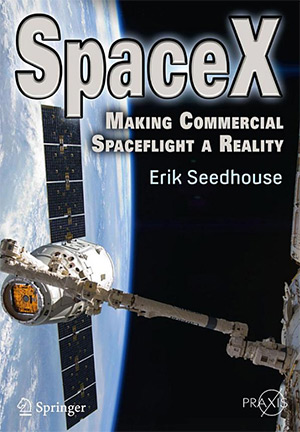Category: Non-Fiction
Reviewed by: David Brandt-Erichsen
From Ad Astra Winter 2013
Title: SpaceX: Making Commercial Spaceflight a Reality
Author: Erik Seedhouse
NSS Amazon link for this book
Format: Paperback
Pages: 226
Publisher: Springer/Praxis
Date: June, 2013
Retail Price: $34.95
ISBN: 978-1461455134
The publisher accurately bills this book as the “first account of commercial spaceflight’s most successful venture.” SpaceX has captured the imagination and interest of space enthusiasts as well as the general public, and the first book on the subject is likely to garner considerable attention. When I heard about the book, I immediately wanted to be the first person on my block to get my hands on a copy.
Author Erik Seedhouse has written nine other books on space subjects and is noted for writing detailed, factual accounts suitable for the non-technical reader. This book follows suit by compiling most of the publicly available information on SpaceX into a single, interesting-to-read source. Readers need to know, however, that the book is not an “inside” story of SpaceX, since there is no indication that the author interviewed any SpaceX executives or employees.
The book is current as of the second SpaceX Commercial Resupply Services (CRS) mission in March 2013, which successfully docked the SpaceX Dragon spacecraft to the International Space Station (ISS). This was actually the third mission to accomplish this feat—the first being a test flight under the Commercial Orbital Transportation Services (COTS) program. The book very clearly explains all this “alphabet soup,” but at the same time gets to the heart of the matter: that SpaceX made history by being the first private company to orbit a spacecraft and return it to the Earth. NASA has so far contracted with SpaceX for a total of 12 cargo flights to the ISS under the CRS program.
The book begins with biographical information about SpaceX Founder and CEO Elon Musk and the principal designer of the SpaceX Merlin rocket engines, Tom Mueller. The in-house development of the Merlin engines, and the significance of their simplified design, is described in considerable detail.
The development of the single-engine Falcon 1 and the nine-engine Falcon 9 rockets were also described in detail, from the early setbacks (the first three launches of Falcon 1 all failed) to the later spectacular successes (the first three launches of Falcon 9 were so successful that the Dragon docked with the ISS on the third launch). The Falcons are designed to be reusable—if they can be recovered. The book describes the Grasshopper prototype that is being used to develop a method of flying the Falcons back to the launch pad and landing vertically.
The author’s lack of connection with SpaceX becomes apparent in the book’s less-detailed treatment of the 27-engine Falcon Heavy, currently under development, which will be the largest rocket launched since the Saturn V. The book has two sections on Falcon Heavy—one is derived from the SpaceX website, and the other I immediately recognized as being derived from an article on the NSS website!
Two chapters are devoted to the development and future evolution of the Dragon spacecraft. The current Dragon is not yet humanrated, but Musk said that if passengers had been on board, even on its first flight, they would have had a comfortable ride. SpaceX is developing a human-rated version (DragonRider) using NASA funding under two programs (more alphabet soup): Commercial Crew Development (CCDev) and Commercial Crew Integrated Capability (CCiCap). With this funding, SpaceX is developing a launch-abort and landing capability using in-house SuperDraco thrusters attached to the sides of the spacecraft, and also developing a more robust life support system. The second of the two chapters discusses a further evolution, called Red Dragon, which is in the planning stages. It would upgrade the thrusters for landing on Mars and then taking off for a hoped-for sample return mission. Musk’s long-term dream is to settle Mars and be the one to make it happen.
The book is rounded out with an informative chapter on the other space companies that are receiving NASA funding and support in developing launchers and/or spacecraft to carry cargo or people into orbit.
The book emphasizes the financial arrangements with NASA that were so important to SpaceX’s success. The author concludes that NASA’s $396 million investment in SpaceX that culminated in the first Dragon flight to the ISS was “the best investment NASA ever made” and “a rare bargain for taxpayers.” Although this was less money than NASA spent on the development of its Orion crew vehicle in the first half of 2012 alone, it resulted in a complete Falcon-Dragon space transportation system that operates at far lower cost than any previous system. ”SpaceX and its Dragon are indisputable proof that a new approach to space transportation can work far more effectively than the old ways.”
If you are looking for a good compilation of information about SpaceX, this book is recommended. But if you are looking for the inside story of SpaceX, that has yet to be written.
© 2013 David Brandt-Erichsen
Please use the NSS Amazon Link for all your book and other purchases. It helps NSS and does not cost you a cent! Bookmark this link for ALL your Amazon shopping!




















